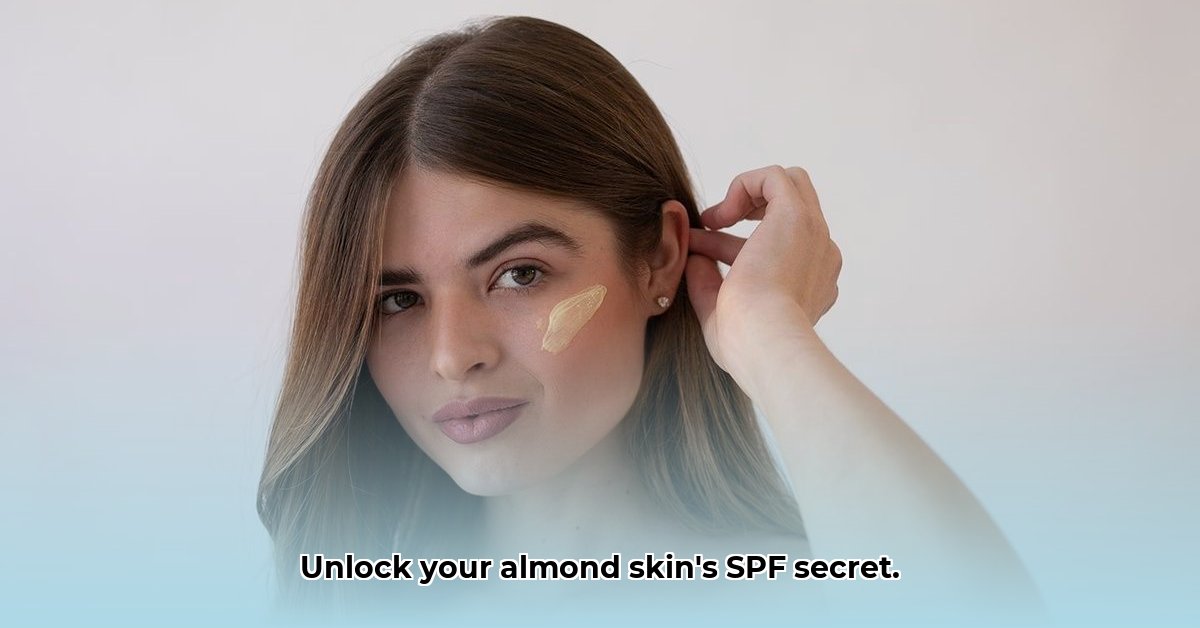Finding the right sunscreen can feel overwhelming, especially when you have almond skin. Learn more about almond skin tones here. Sun protection is paramount for maintaining its unique radiance and preventing hyperpigmentation. This comprehensive guide provides everything you need to choose the perfect SPF, apply it effectively, and seamlessly integrate it into your daily routine for healthy, glowing skin. We’ll explore the characteristics of almond skin, guide you in identifying your undertones (warm, cool, or neutral), offer dermatologist-approved tips, and suggest specific product recommendations to help you avoid common sunscreen mistakes.
SPF for Almond Skin: Unveiling Sun-Kissed Confidence
Almond skin, with its captivating medium-brown hue and warm, cool, or neutral undertones, deserves optimal protection from the sun’s damaging rays. This guide empowers you with the knowledge to choose an SPF that aligns with your unique skin type, lifestyle, and preferences, ensuring you maintain healthy, radiant skin for years to come. Let’s embark on your journey to sun-kissed confidence!
Decoding Your Unique Undertone: Warm, Cool, or Neutral?
Before selecting an SPF, accurately identifying your skin’s undertone is crucial. This will influence how your skin responds to the sun and which SPF formulations will complement your complexion. Does your almond skin exhibit a golden, yellow, or peachy cast (warm undertone)? Or does it lean towards pink, blue, or rosy hues (cool undertone)? Alternatively, does it appear to have a balance of both, making it neutral?
Here’s a detailed guide to help you determine your undertone:
- The Vein Check: Carefully examine the veins on your inner wrist in natural light. Bluish or purplish veins typically suggest a cool undertone, while greenish veins often indicate a warm undertone. If your veins appear to be a mix of both, you may have a neutral undertone.
- The Jewelry Test: Hold both gold and silver jewelry against your skin, one at a time. Observe which metal enhances your complexion more effectively. If gold illuminates your skin and imparts a healthy glow, you likely possess a warm undertone. If silver is more flattering, brightening your skin and reducing redness, you likely have a cool undertone. If both gold and silver appear equally flattering, you may have a neutral undertone.
- The White Fabric Test: In natural light, hold a pure white piece of clothing or paper next to your face. Then, try an off-white or cream-colored fabric. Observe which shade makes your skin appear brighter and more even. If white makes your skin look radiant and clear, you likely have cool undertones. If cream is more flattering, softening your complexion, you probably have warm undertones. If you notice minimal difference, you may have a neutral undertone.
- The Sun Exposure Test: Reflect on how your skin typically reacts to sun exposure. If you tan easily and develop a rich, golden-brown color, you likely have a warm undertone. If you tend to burn before tanning, or burn easily overall, you’re more likely to have cool undertones. If you tan gradually without significant burning, or experience minimal color change, a neutral undertone is probable.
Remember that undertones can be subtle, and some individuals may exhibit characteristics of multiple undertones. If you’re still uncertain, consult with a professional makeup artist or dermatologist for personalized assistance.
Selecting Your Perfect SPF: Delving Beyond the Numbers
Choosing the right SPF involves considering several critical factors beyond simply selecting a high SPF number. Prioritize these important considerations:
- SPF Level: Opt for a minimum SPF of 30. While SPF 30 blocks approximately 97% of UVB rays, higher SPF levels, such as 50 or 50+, offer slightly greater protection, blocking around 98% of UVB rays. This additional protection can be beneficial, especially during prolonged sun exposure or in environments with intense sunlight.
- Broad Spectrum Protection: Scrutinize the label to ensure your SPF provides broad spectrum protection, shielding your skin from both UVA and UVB rays. UVA rays penetrate deeply into the skin, contributing to premature aging, wrinkles, and an increased risk of skin cancer. UVB rays are primarily responsible for sunburn and also contribute to skin cancer development.
- PA Rating (for UVA Protection): Almond skin tones are particularly susceptible to hyperpigmentation, making UVA protection paramount. Seek out sunscreens with a PA+++ or PA++++ rating. The PA system, primarily used in Asian countries, indicates the level of protection against UVA rays. PA+++ offers high UVA protection, while PA++++ provides extremely high UVA protection.
- Skin Type Compatibility: Carefully consider your skin type when selecting an SPF formulation. If you have oily or acne-prone skin, opt for a non-comedogenic, oil-free, or gel-based formula to minimize the risk of clogged pores and breakouts. If your skin is dry, choose a moisturizing SPF cream or lotion containing hydrating ingredients like hyaluronic acid, glycerin, or ceramides to prevent dryness and flakiness. Sensitive skin types should seek out fragrance-free, hypoallergenic SPFs formulated with gentle ingredients like zinc oxide or titanium dioxide.
- Sunscreen Type (Mineral vs. Chemical): Mineral sunscreens (also known as physical sunscreens) contain zinc oxide and titanium dioxide, which create a physical barrier on the skin to reflect UV rays. They are generally considered gentler and less irritating, making them a good choice for sensitive skin. Chemical sunscreens contain chemical filters that absorb UV rays. Some individuals may be sensitive to these filters.
- Water Resistance: If you plan to swim or sweat, choose a water-resistant sunscreen. However, keep in mind that no sunscreen is completely waterproof. Reapplication is necessary after swimming or excessive sweating, as indicated on the product label (usually every 40 or 80 minutes).
Finding the perfect SPF is a highly personal process that often requires experimentation and trial-and-error. Delve into online reviews, seek recommendations from friends or dermatologists, and don’t hesitate to purchase sample sizes to test different options before committing to a full-size product.
Mastering SPF Application: A Step-by-Step Protocol for Optimal Protection
Proper SPF application is crucial for achieving adequate sun protection. Adhere to these steps for maximum efficacy:
- Cleanse Your Skin: Begin with a thoroughly cleansed face to ensure the SPF can effectively penetrate the skin and provide optimal protection.
- Hydrate with Moisturizer: Apply your regular moisturizer to create a smooth, hydrated base. This step enhances SPF absorption, prevents dryness, and creates a more even canvas for makeup application (if desired). Allow the moisturizer to absorb fully before proceeding to the next step.
- Apply SPF Liberally: Dispense a generous amount of SPF onto your fingertips. A general guideline is to use approximately one shot glass-full (about one ounce or 30 milliliters) for your entire face and body. This amount is typically more than most people realize they need.
- Even Distribution: Gently massage the SPF into your skin, ensuring even coverage across all exposed areas, including your face, neck, ears, and any other skin that will be exposed to sunlight. Pay close attention to often-neglected areas like the hairline, the back of the neck, and the tops of your feet.
- Time for Absorption: Allow the SPF to absorb into your skin for at least 15 minutes before venturing outdoors. This allows the protective filters to bind to the skin and form a protective barrier.
- Reapplication is Key: Reapply SPF every two hours, regardless of the SPF number. Reapplication is essential to maintain adequate protection, especially after swimming, sweating heavily, or toweling off. Set a timer or use a reminder app to ensure timely reapplication.
Seamlessly Integrating SPF into Your Daily Routine: Effortless Sun Protection
Making SPF application a non-negotiable part of your daily routine is essential for long-term skin health. Here’s how to seamlessly integrate it into your morning regimen:
- SPF as the Final Step: Apply SPF as the final step in your skincare routine, after your moisturizer and before applying any makeup.
- Dedicated SPF Products: Consider using a dedicated SPF product specifically formulated for facial use. These products are often lighter in texture, non-comedogenic, and designed to wear well under makeup.
- SPF-Infused Makeup: Explore makeup products with built-in SPF, such as tinted moisturizers, foundations, and BB creams. While these products provide some sun protection, they should not be relied upon as your sole source of SPF. It’s still essential to apply a dedicated SPF underneath.
Beyond SPF: A Holistic Approach to Sun Safety
While SPF is an indispensable component of sun protection, it’s most effective when combined with other protective measures. Enhance your sun safety strategy with these additional practices:
- Seek Shade Strategically: Minimize direct sun exposure during peak hours, typically between 10 a.m. and 4 p.m., when the sun’s rays are at their strongest. Utilize shade provided by trees, umbrellas, or buildings. The National Weather Service provides UV Index forecasts to help you plan your outdoor activities.
- Embrace Protective Clothing: Don loose-fitting, tightly woven clothing that covers as much skin as possible. Opt for long-sleeved shirts, long pants, and dresses made from sun-protective fabrics.
- Accessorize with Hats and Sunglasses: Shield your face and eyes from the sun’s rays by wearing a wide-brimmed hat that casts a shadow over your face, neck
- Plant-based Diet Colitis Remission: Success Stories - December 18, 2025
- Plant Based Diet Breast Cancer: Research-Based Benefits - December 16, 2025
- Plant-Based Diet Ulcerative Colitis Remission: Proven Benefits - December 15, 2025










